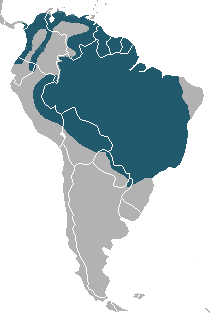Buss dug
Appearance
The "Scots" that wis uised in this airticle wis written bi a body that haesna a guid grip on the leid. Please mak this airticle mair better gin ye can. (Februar 2021) |
| Buss dug[1] | |
|---|---|

| |
| Scientific classification | |
| Kinrick: | Animalia |
| Phylum: | Chordata |
| Cless: | Mammalia |
| Order: | Carnivora |
| Faimily: | Canidae |
| Genus: | Speothos |
| Species: | S. venaticus |
| Binomial name | |
| Speothos venaticus (Lund, 1842)
| |
| Subspecies | |
| |

| |
| Buss dug scowth | |
The buss dug (Speothos venaticus) is a canid hamelt in Central an Sooth Americae.[1][2] In spite o its muckle scowth, it is very rare in maist airts but Suriname, Guyana an Peru;[2][3] it wis first identified bi Peter Wilhelm Lund as fossils in Brazilien caves an believed tae be extinct. The buss dug is the anely livin species in the genus Speothos,[1] an genetic evidence suggests that its closest livin relative is the maned wouf that bides central Sooth Americae.[4]
In Brazil it is cried cachorro-vinagre ("vinegar dug") or cachorro-do-mato ("buss dug"). In Spainish-speakin kintras it is cried perro vinagre ("vinegar dug"), zorro vinagre ("vinegar tod"), perro de agua ("watter dug"), or perro de monte ("muntain dug").
References
[eedit | eedit soorce]- ↑ a b c Wozencraft, W. C. (2005). "Order Carnivora". In Wilson, D. E.; Reeder, D. M (eds.). Mammal Species of the World (3rd ed.). Johns Hopkins University Press. ISBN 978-0-8018-8221-0. OCLC 62265494.
- ↑ a b c DeMatteo, K., Michalski, F. & Leite-Pitman, M. R. P. (2011). "Speothos venaticus". IUCN Reid Leet o Threatened Species. Version 2011.2. Internaitional Union for Conservation o Naitur. Retrieved 18 Januar 2012. Cite has empty unkent parameter:
|last-author-amp=(help)CS1 maint: multiple names: authors leet (link) CS1 maint: ref=harv (link) Database entry includes justification for why this species is near threatened - ↑ de Mello Beiseigel, B. & Zuercher, G.L. (2005). "Speotheos venaticus". Mammalian Species: Number 783: pp. 1–6. doi:10.1644/783.1.CS1 maint: multiple names: authors leet (link)
- ↑ Wayne, R.K.; et al. (1997). "Molecular systematics of the Canidae". Systematic Biology. 46 (4): 622–653. doi:10.1093/sysbio/46.4.622. PMID 11975336. Explicit use of et al. in:
|author=(help)
| This canid-relatit airticle is a stub. Ye can help Wikipaedia bi expandin it. |

